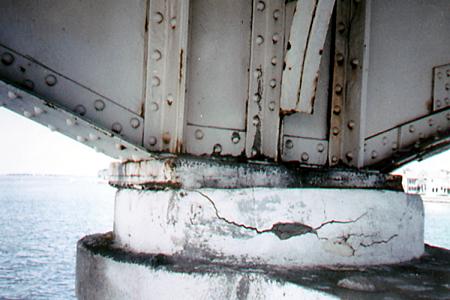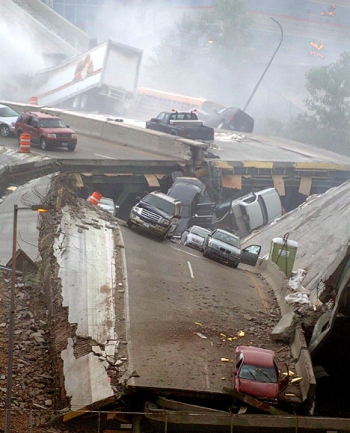If you left your grandma’s old wicker chair out on the porch all winter – and the next, and the next, and the next for 20 years – would you still trust that chair to hold you if you sat down?

According to Barry LePatner, author of the new book Too Big to Fall: America’s Failing Infrastructure and the Way Forward, you shouldn’t trust our country’s bridges much more than you trust that chair. He calls them “ticking time bombs” and “tragedies waiting to happen.”
But, he says, there’s good news. You’ve heard the estimates that a quarter of the nation’s bridges are either “structurally deficient” or “functionally obsolete.” That’s more than 160,000 bridges to repair or replace. But rather than throw up our hands and say the problem is too big, LePatner urges us to take a look at a much more significant – and manageable – number: 7,980.
“Forget ‘structurally deficient.’ Forget ‘functionally obsolete,’” LePatner told a group of experts in Washington, DC last week. He urges a new focus on bridges he calls “fracture-critical.”
“A ‘fracture-critical’ bridge is a bridge designed where if one critical member of the bridge fails – one piece –the entire bridge goes down like a house of cards,” he said, “It has no redundancy.”
He’s done an exhaustive analysis and found that there are 18,000 fracture-critical bridges in the U.S. and almost 8,000 of those are also structurally deficient. “Since 1989, nearly 600 bridges in this nation have failed,” LePatner said. “Without immediate repair, those nearly 8,000 fracture critical and structurally deficient bridges will fail as well.”
The narrower focus could be reassuring to governors worried about the overwhelming number of bridges in need of repair in their states. The tragedy in Minneapolis in 2007 is a bitter reminder to all of us – especially to politicians – that ignoring these maintenance needs is not an option. The bridge on I-35W was both fracture-critical and structurally deficient. So was the Champlain Bridge between New York and Vermont that was dynamited last year for safety reasons.
So why is it taking so long to attend to these needs? Advocates of a fix-it-first approach to highways are familiar with the problem, as LePatner describes it:
It’s exciting for politicians to plan and promise a new bridge. They love to stand next to oversized renderings of the new bridge against a brilliant blue sky. But to maintain one, nobody gets too excited about that. And no politician wants to spend limited capital budget expenditures on something you can’t see, something you can’t show your constituents, or have a ribbon cutting ceremony with happy campaign contributors at your side. From the outside, a new bridge looks pretty much like an old one.

Meanwhile, bridge repair isn’t just a safety issue; it’s an issue of sprawl. The bridges at the top of state DOTs' lists to replace aren't necessarily the most decrepit ones. Often, agencies will place priority on replacing the most congested bridges with wider ones that induce driving and sprawl.
Veronica Vanterpool of the Tri-State Transportation Campaign attributes the problem to old-school transportation officials that hold the pursestrings. "Traffic engineers in a lot of the state DOTs have been there for generations," Vanterpool said in an interview with Streetsblog. "And [building new capacity instead of repairing existing bridges] is an old approach to traffic demand management. And it's just not an approach that is sustainable today. When you build new roads it just attracts more traffic, more congestion, and when you widen existing roads it's the same deal."
LePatner also describes the “perverse incentives” that encourage politicians to let bridges fall into disrepair. “If you have a bridge that’s new, were you to maintain it at the cost of a million dollars a year, that comes out of your state general budget,” he said. “If you let it deteriorate, and 20 years later you now rate it structurally deficient or poor, you qualify for federal funding. So you’re better off, to get monies from the federal government, by letting your bridges deteriorate."
Many attendees of LePatner’s presentation, including former Pennsylvania and Colorado DOT official Jack Kinstlinger, took offense at LePatner’s portrayal of DOT negligence. “We did all kinds of analyses, and the bridges without redundancy went at the top,” Kinstlinger said in response to LePatner's assertion. “Most states spend an incredible amount of money getting it right.”
Of course, getting it right means rebuilding old bridges with access for multiple modes, as we reported last week. Bridge reconstruction presents a great opportunity for cyclists and pedestrians to ensure that they’re kept in mind in the design process.
Are there fracture-critical and structurally deficient (ie, unsafe) bridges in your community? LePatner says he’s working on geo-mapping the bridges online, but the maps won’t be ready for a few more months.





